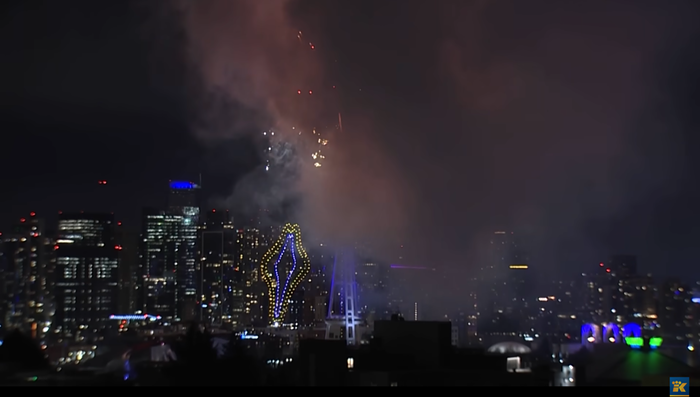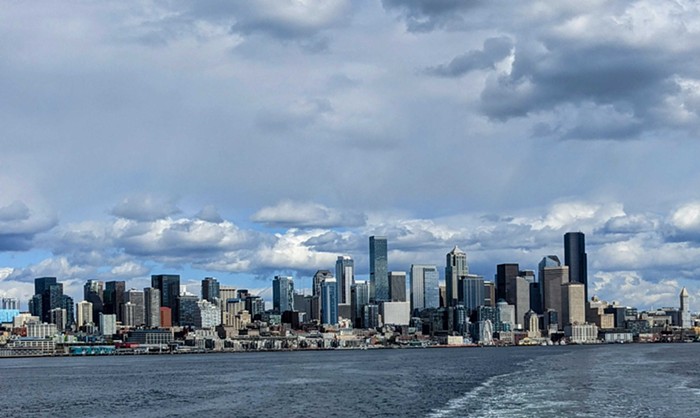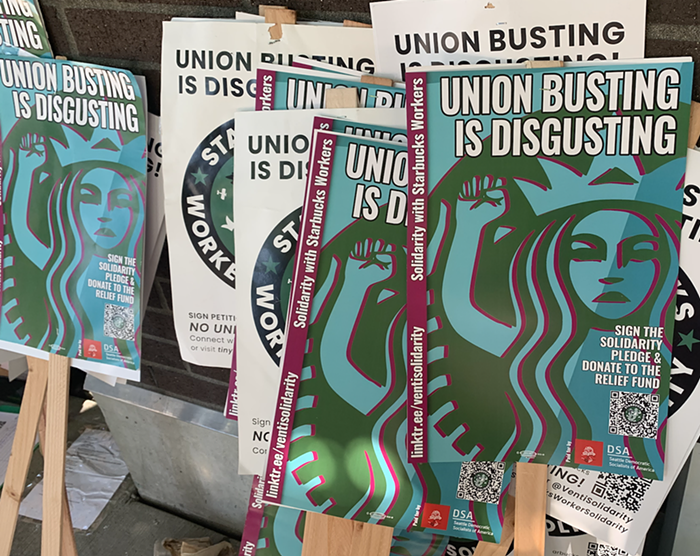
Initially published on December 22, 2020.
“The snow doesn't give a soft white damn Whom it touches,” e e cummings once wrote, and I eagerly await the soft white damnation awaiting us this weekend. Seattle is a beautiful city, but somehow it is even more beautiful when covered so completely it cannot be seen.
Yesterday’s light dusting of parmesan will probably be outdone this weekend, with several inches and high winds predicted tonight, possibly cutting power, stranding drivers, downing trees, and generally causing frosty mayhem. You've got a few hours left to stock up on supplies, coordinate your sledding plans, and charge your devices.
SHOPPING FOR A SNOWSTORM
The city advises that you stock up in advance with a handful of supplies: a snow shovel, a bag of street salt, warm clothes and blankets, flashlights, first aid kits, and enough food and water and medicine for three days. I also recommend having an electric blanket or hand warmer nearby — and also waterproof winter boots. (I got these Hoka One One boots a few months ago and love them; the sole is much thicker than I expected and took awhile to get used to, but now I enjoy being several inches taller than I’m supposed to be.)
Regarding food: You will likely be grateful for easy, warm recipes; if you like to cook, I recommend a roast (of beef or a Harvest Loaf if you’re vegan) with mushroom soup. If you’re unsure about how to be in a kitchen, get a few plain frozen pizzas and a handful of toppings to throw on ahead of time. For a larger project, whole-body chickens were on sale at QFC yesterday, and this is a fine opportunity to learn how to spatchcock and roast a chicken.
If you’re the custodian of a sidewalk in front of your property, you’ll need to keep ice from forming. Sprinkle some rock salt on the sidewalk ahead of time, and shovel twice a day while the snow is falling. Every year, a handful of people try using kitty litter to de-ice the sidewalks. Do not do that, please.
POWER OUTAGES DURING A SNOWSTORM
The city projects that it may be unable to meet peak demand for power in 2021. On top of that, wind and falling branches account for about half of local outages — only in the downtown area are power lines protected underground. (Which makes them vulnerable to vault fires, a topic for a separate panic-piece.) If you were here in 2006, you’ll remember how parts of the city went without power for up to a week after a particularly bad outage.
Here’s how to prepare ahead of time: First, make sure you have three days of food and water on hand. Have a written-down list of contacts outside the area so you can let people know you’re okay — or that you need help. Have a little cash on hand in case ATMs don’t work. Know where the closest land-line is.
During an outage, don’t use generators or grills inside your home. Keep the fridge closed. And unplug electronic devices, because they could be damaged when power comes back on.
And if you have medicine that needs refrigeration, or medical equipment that needs power, work with a medical provider to make sure your care isn’t interrupted. Check the city’s Lifeline program, which works with people whose health may be impacted by power interruptions.
STREET CLOSURES & SLEDDING WHEN IT SNOWS
Seattle doesn’t have any dedicated snowplows — when streets need clearing, the city just sticks plows on the front of whatever other trucks happen to be handy. There aren’t enough of those trucks to handle the whole city, and some streets are too steep to be plowed, so when heavy snow comes, you should be prepared for some streets to remain covered until it melts. That means you might not be able to get to the store for some time.
But it also means that some streets will become giddy slopes for sledders. (East Denny Way and Queen Anne Avenue are particularly vertiginous even when it is not snowing.) This is, it must be pointed out, illegal and carries a potential $112 fine, which means that authorities may intervene in the fun … if they are provided with a reason to do so.
If you do decide to seek out some sledding fun, keep your wits about you for heaven’s sake and don’t careen uncontrollably toward cross-traffic, trees, and rocks. A local girl died of a head injury in a sledding accident back in the ‘80s, so consider bringing a helmet, particularly if you’re sledding with young people.
DRIVING IN THE SNOW
Here’s how to drive safely when it snows: Don’t.
Just stay off the road. Really. Even under the best of conditions, there’s no such thing as a crash-proof car; but when there’s ice and reduced visibility, you’re heading into significantly heightened danger.
If you absolutely must drive, slow down. Check the WSDOT’s recommendations for traction tires and chains — certain roads will be blocked off unless you have them on your car. Check for pass closures here.
And make sure your car is well-stocked with supplies: A flashlight, batteries, a blanket, snacks, gloves, boots, first aid, spare cell phone battery, jumper cables, flares, sand, and a whistle. In 1991, an elderly couple got stuck in the snow in California and left a diary of their slow deaths over several days and I have never been able to get the story out of my mind.
HOUSING RESOURCES
It’s easy to offer advice like “make sure you have enough blankets,” but over ten thousand people in King County don’t even have permanent stable shelter. Last year, a man with no fixed address died at the Sodo light rail station during cold weather, and this year the pandemic makes it even harder to secure safe shelter.
The city has opened three severe weather shelters for this weekend: Fisher Pavilion at Seattle Center (305 Harrison Street near the Armory), Bitter Lake Community Center (13035 Linden Ave North), and Garfield Community Center (2323 East Cherry Street). They’ll be open through Monday, the 15th; they’re set up to conform to COVID safety standards; and they’ll offer meals and showers.
King County has opened an additional shelter at Jefferson Day Center (420 4th Ave) — it’s men’s-only, and will be open through Saturday.
There are several resources that may be able to help if you’re outside during dangerously cold temperatures. Urban Rest Stop can provide warm showers, laundry, and restrooms, and Solid Ground provides transportation downtown. You can find a directory of shelters here, and also by calling 211. Seattle just launched a new initiative called HOPE, or “Homelessness Outreach Provider Ecosystem,” with the goal of finding shelter for about 5% of Seattle’s unhoused population — way to dream big.
LANDSLIDES — YES, REALLY
Seattle experienced a series of damaging landslides in 1996 and 1997, including one that killed a family on Bainbridge Island. A little more than 8% of the city has been identified as slide-prone, about a third of which is designated as single-family residential, and they can occur without warning, particularly after rapid snowmelt.
Fortunately, there’s an online tool that monitors and reports on Seattle’s landslide risk — updated once per hour, the graphs indicate the relative risk of landslide based on a variety of factors. If you live along Seattle’s northwest or northeast slopes, you should be particularly attentive to risk, because landslides have been increasing in those areas according to the city. Areas of recent landslide activity include Southwest Magnolia, Northwest and Southwest Queen Anne, East Queen Anne, Alki, Admiral Way, West Beacon Hill, Interlaken, Madrona, and Pigeon Point.
SO MUCH FOR GLOBAL WARMING
If you have the misfortune to encounter someone who thinks that a snowstorm disproves the existence of climate change, grab them by the lapels, shake them violently, and scream into their face “CLIMATE,,, IS DIFFERENT,,, FROM WEATHER.”
Then you can go back to remarking on how it's really coming down out there.



















